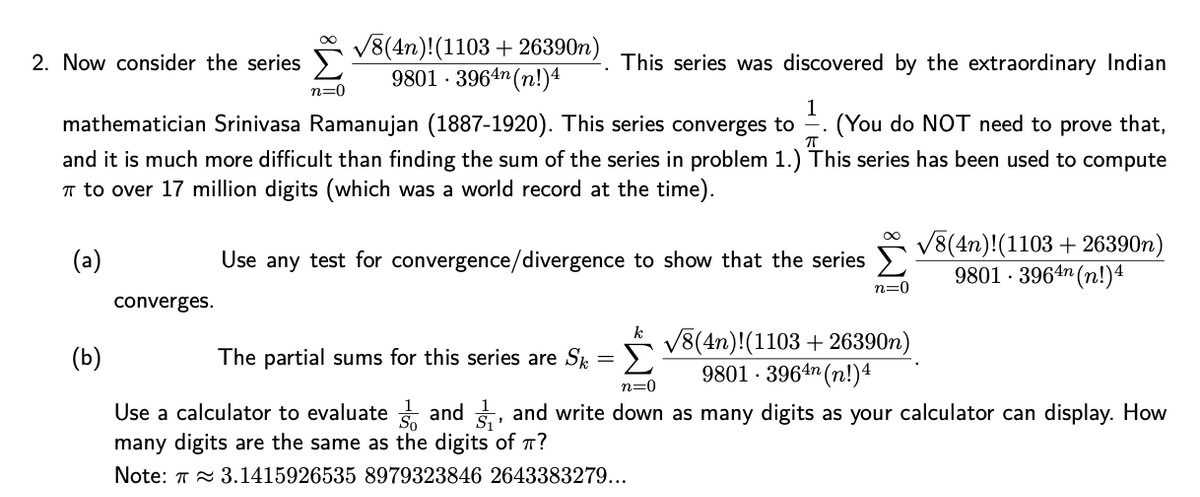2. Now consider the series v8(4n)!(1103 + 26390n) 9801 · 3964n (n!)4 This series was discovered by the extraordinary Indian n=0 mathematician Srinivasa Ramanujan (1887-1920). This series converges to 1 (You do NOT need to prove that, and it is much more difficult than finding the sum of the series in problem 1.) This series has been used to compute T to over 17 million digits (which was a world record at the time). V8(4n)!(1103 + 26390n) 9801 · 3964n (n!)4 (a) Use any test for convergence/divergence to show that the series n=0 converges. k V8(4n)!(1103 +26390n) 9801 · 3964n (n!)4 (b) The partial sums for this series are Sk Σ n=0 Use a calculator to evaluate and , and write down as many digits as your calculator can display. How many digits are the same as the digits of a? Note: 7 3.1415926535 8979323846 2643383279...
2. Now consider the series v8(4n)!(1103 + 26390n) 9801 · 3964n (n!)4 This series was discovered by the extraordinary Indian n=0 mathematician Srinivasa Ramanujan (1887-1920). This series converges to 1 (You do NOT need to prove that, and it is much more difficult than finding the sum of the series in problem 1.) This series has been used to compute T to over 17 million digits (which was a world record at the time). V8(4n)!(1103 + 26390n) 9801 · 3964n (n!)4 (a) Use any test for convergence/divergence to show that the series n=0 converges. k V8(4n)!(1103 +26390n) 9801 · 3964n (n!)4 (b) The partial sums for this series are Sk Σ n=0 Use a calculator to evaluate and , and write down as many digits as your calculator can display. How many digits are the same as the digits of a? Note: 7 3.1415926535 8979323846 2643383279...
Chapter9: Sequences, Probability And Counting Theory
Section: Chapter Questions
Problem 25RE: Use the formula for the sum of the first nterms of a geometric series to find S9 , for the series...
Related questions
Question

Transcribed Image Text:V8(4n)!(1103 + 26390n)
9801 · 3964m (n!)4
2. Now consider the series >
This series was discovered by the extraordinary Indian
n=0
mathematician Srinivasa Ramanujan (1887-1920). This series converges to
1
(You do NOT need to prove that,
and it is much more difficult than finding the sum of the series in problem 1.) This series has been used to compute
T to over 17 million digits (which was a world record at the time).
V8(4n)!(1103 + 26390n)
9801 · 3964n (n!)4
00
(a)
Use any test for convergence/divergence to show that the series
n=0
converges.
k
V8(4n)!(1103 + 26390n)
9801 · 3964n (n!)4
(b)
The partial sums for this series are Sk = >
n=0
Use a calculator to evaluate and , and write down as many digits as your calculator can display. How
many digits are the same as the digits of T?
Note: T 2 3.1415926535 8979323846 2643383279...
Expert Solution
This question has been solved!
Explore an expertly crafted, step-by-step solution for a thorough understanding of key concepts.
Step by step
Solved in 2 steps

Recommended textbooks for you


Algebra & Trigonometry with Analytic Geometry
Algebra
ISBN:
9781133382119
Author:
Swokowski
Publisher:
Cengage


Algebra & Trigonometry with Analytic Geometry
Algebra
ISBN:
9781133382119
Author:
Swokowski
Publisher:
Cengage